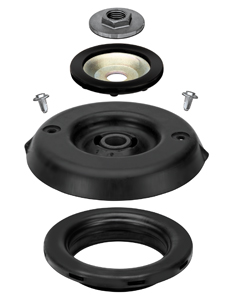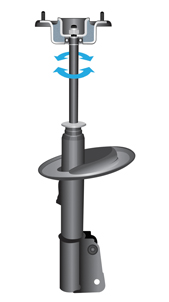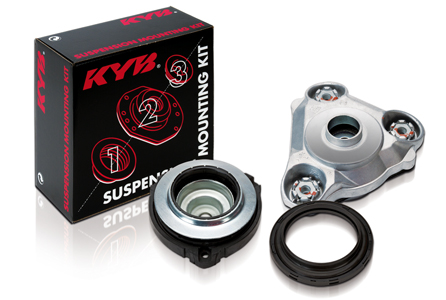
Have you ever replaced a shock absorber and put the old suspension mounting kit back on? If you were brave enough to admit it, you will be pleased to know you are not the only person!

Just like a shock absorber, a suspension mounting kit is pushed and pulled 1,500 times every mile – over the course of 50,000 miles that means this small but important component has moved 75 million times. Imagine how that amount of work will deteriorate the components in the mounting.
Suspension mounting kits optimise suspension and steering performance by:
a) Acting as a pivot for the steering mechanism, providing a smooth steering response;
b) Reducing squeaks, rattles and vibration noise.
 Worn mountings have an adverse effect on ride control and safety. Mount wear depends on the type of travel, driving characteristics and the individual vehicle, however a good guideline is that if the struts are worn out, the mounts will probably be worn out too. Strut mounts should therefore be replaced every time you replace struts.
Worn mountings have an adverse effect on ride control and safety. Mount wear depends on the type of travel, driving characteristics and the individual vehicle, however a good guideline is that if the struts are worn out, the mounts will probably be worn out too. Strut mounts should therefore be replaced every time you replace struts.
Characteristics of a worn mounting kit
* Clunking noises
* Vibration
* Loose or stiff steering
* Poor alignment
* Tyre wear
Visual signs of a worn mounting kit
* Cracked and/or sagging rubber
* Corrosion
* Deformed or bent parts
* Pitted rubber
Suspension mounting kits improve vehicle handling, ride control, alignment, braking and steering. They should be replaced every time you replace a vehicle’s shock absorbers.
 Garage and sales training
Garage and sales training
KYB UK – a leading supplier of shock absorbers, coil springs and suspension mounting kits – provides valuable technical training for its garage customers. The company’s training programme for technicians advises them on what to look out for when checking for worn shock absorbers and springs on a car.
Sue Clough, Customer Service Manager, KYB UK, says: “Our training programme helps garages to look for physical signs of wear on shocks and springs, as well as the symptoms they would feel driving a vehicle. Training sessions are normally held at an individual garage customer’s premises or given to a group of garages at a central location.
“In addition we supply visual aids, including leaflets and point-of-sale material which garages can use to explain to motorists the importance of checking shocks and springs as they are safety critical components. Their replacement also represents a great sales opportunity for our independent garage customers.”









